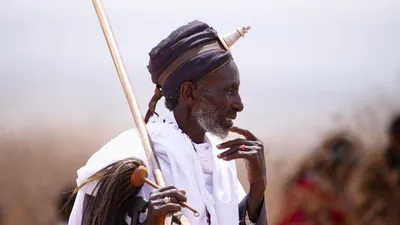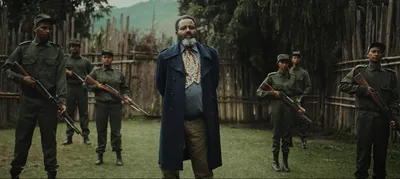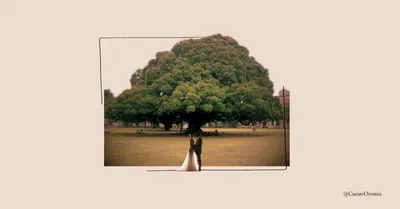The Naming Ceremony of an Oromo Child

Borana children near the Bale Mountains, Oromia, Ethiopia
During the analog era, back when CDs and DVDs were not common, my father had a favorite tape cassette that he enjoyed listening to. It was a recording of a group of men singing traditional Oromo folk songs. Apparently, it was after I was born that a Gubbissa also known as Maqaabaasa was held for me and my two siblings. Qabale Jirma, a journalist, and sister of the legendary Borana artist Abdullahi Jirma, broadcast the ceremony on the (Kenyan) national radio. I was too young to recall but whenever that cassette played, the voices of my father, my elder brother, and other elders singing would transport me back in time. Unfortunately, the cord of that cassette was badly damaged and I lost it but the memory still lingers in my mind.
So what exactly is Maqaabaasa or Gubbissa? How is it celebrated? And who is Ali Gurraacha Yaayya Munyo who is mentioned in the song? To find answers to these questions, I asked Obbo Liban Halake Duba, a Borana “Argaa Dhageettii.”
Argaa Dhageettii?
Argaa Dhageettii comes from the Oromo words Argaa which refers to “that which is seen” and Dhageeti, which refers to “that which is heard.” Together, it refers to events that have been witnessed in the present and those handed down by word of mouth from the past. A person trained from a young age for this role is known as Nama Argaa Dhageettii, or a man of Argaa Dhageettii, in Oromo culture. In fact, in the Gadaa System, the Oromo word for History is “Argaa Dhageettii” and the custodians of Oromo history (who passed it down through oral narrations from generation to generation) the preservers of culture and identity are men of Argaa Dhageettii. Obbo Liban is one of many such men, and he was generous enough to share his wisdom with me.
Our conversation began with a blessing and prayer, Obbo Liban noted. “Duraan durse eebban banamnaa:
Bara bariin nagaa
Halkanii fi guyyaan nagaa
Ollaa fi Reerriin nagaa
Dheedaaf Gooroon nagaa
Liiban fi Dirreen nagaa
Dirrii Liiban nagaa
Baddaan Sadeen nagaa
Horaa bulaa deebanaa
Hangafaa fi maandhan bula, isin jedhaa…”
In Oromo culture, names are the bearers of one’s identity, says Obbo Liban. As such, when a child is born, it will take two to three years before they are named in a collective ceremony. This ceremony is called Gubbissa or Maqaabaasa. Until this ceremony, the parents can call their child whatever terms of endearment or unofficial names they like.

The preparations for the ceremony begin early. Because the firstborn child (Hangafa) is held in higher regard and honor, his/her Gubbissa is announced one year in advance. When the time comes, a traditional house will be built in three days for the ceremony.
The duration of the ceremony also has different rules: if the child is a firstborn, his/her ceremony will last for three days. If it is not a firstborn, his/her ceremony will last for one day. The elders will have Buna-Qalaa (roasted coffee) for prayers and blessings, with the parents of the child dressed in traditional Oromo attire and jewelry. For example, the father would tie their Ruufa (an Oromo traditional turban), wear a Kallo, and hold a Lichoo (traditional whip) while the mother would adorn herself with Ummur, Saqaa and style her hair in cornrows.
The folk songs of the ceremony flow one after the other in an orderly manner. The second song, which remains etched in my mind, is dedicated to recognizing Ali Gurraacha Yaayya Munyoo, the person responsible for restoring the Gadaa System back to the Boranas after more than twenty years without practicing it. The song is also a form of prayer for the child to grow strong and healthy. It goes:
“Yoo Aliyoo, Alii Gurraacha,
Gurraachi Yaayya, Yaayya Munyoo,
Diida munyuuxee, daraara dheedde
Daraara marraa, Waaqa sifeessi
Daraara ilma, Waaqa guddissii”
It is also worth noting that the Munyoo Yaayya Oromos who live in Tana River County, Kenya, named themselves after this man.
In Oromo culture, one cannot name his/her child as one pleases. For example, names such as Liban and Boru are specially categorized only for firstborns, or Hangafa in Afaan Oromoo. Borana Oromos have a saying that goes, “Waaqa boruun hangafa, Liiban lafa hangafa.” “The sky’s morning sunrise is the first and Liban’s land is the first,” meaning every Borana Oromo, whether he/she lives in Ethiopia or Kenya, traces Liban, a district in East Borana Zone of Oromia regional state as his/her ancestral land. So it is in this respect that these kinds of names are only fit for a firstborn.
Gubbissa is still practiced in Southern Oromia today and Marsabit county, in Kenya, and most likely in several places where Oromos live, perhaps under a different name or a slightly different manner.
Traditional names have been deemed “backward” in our modern world as a result of influences from the Abrahamic religions, excessive exposure to other foreign cultures, and the influence of urban lifestyle. This has led to the popularity of foreign names rather than being proud of our own. As such, in my opinion, the abandonment of our African names slowly also made possible the abandonment of our cultural practices, and by extension our identity. I was the last of my generation in Isiolo County, Kenya, to have had a Gubbissa.
In the countryside, people are generally proud of their African roots, their traditions, culture, and their way of life has not been impacted by the negative influences of the modern, digital world. We need to at least emulate this from them and firstly, be proud of our ancestral names and then the topic of the naming ceremony might be viable for discussion.
I have always said that my children will have Oromo names, just like my grandparents and great-grandparents. It is not that I have anything against Arab, Amharic, Asian, or Western names, but simply because I am Oromo, just like my ancestors, and so will be my descendants.
I am writing this article to urge my fellow Oromos to unite and preserve their identity and cultural practices, such as Gubbissa. These cultural practices may be known by a different name or practiced in a different way in different parts of Oromia, but they are probably still there. For instance, I have heard of a similar cultural practice called Moggaasaa in Hararge, Oromia, which is practiced among the Ittu-Humbanna Oromo.
It is important for our scholars to come together and share ideas on how to preserve these cultural practices. Once we have collectively outlined a plan, the responsibility of carrying it out and passing it on to the next generation will fall solely on us, the Oromo people.
For example, I will have to make sure that my child has the Gubbissa ceremony, just as I did. This will help to revive the Gubbissa ceremony in Isiolo, as it is expected for all Oromos living in Oromia and the diaspora.
I hope that my generation will follow in the footsteps of Ali Gurraacha, who restored the Gadaa System among the Borana after more than two decades. I hope that we can restore all our beautiful cultures so that future generations can enjoy their childhood as much as we did, have a clear sense of self, know their culture, and be proud of their identity.
We need your support
We trust you found something of value in this article. If so, we kindly ask you to consider helping Curate Oromia continue its work.
If you believe in the importance of independent voices and honest reporting, we invite you to support our efforts through our GoFundMe campaign.
Every contribution, however small, goes directly to our writers and the expansion of our reach.
Thank you for your support.



